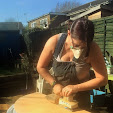Ever since I was a kid, watching American movies, I had heard about jerky or jerked beef. When I asked my parents what it was, they said it was what Americans called biltong. I guess that was a fair enough answer to give to a kid.
Then I went to the US and tasted jerky and, I'm sorry, but it isn't biltong. No offence to any American readers, but I found it vile.
We can get both jerky and biltong in the UK, albeit not readily, but I only buy jerky for the dog. Largely because of its convenient flat strips.
Some of our South African friends who have emigrated to the USA have explained biltong to their new friends as being 'like jerky - only nicer.'
So today I decided to look into what the difference is between the two.
Both are dried, spiced meats, but...
Jerky is prepared by cutting meat into thin strips and soaking it in a sweet, spicy marinade (this is what gives it its sweetish taste). Thereafter, it is cured by drying near a smoky fire.
Biltong is made in much larger pieces, following the grain of the muscle, which are spiced (a key ingredient being ground coriander seeds) and then dried. Sometimes they strips are soaked in a vinegar solution before spicing. Saltpetre can sometimes be used in the spicing.
Both are available in an increasing range of flavours as makers experiment with different recipes.
Both owe their origins to a need to preserve meat. Jerky traces its origins back to native Americans and Incas. Biltong has more recent origins in the Afrikaner voortrekkers who struck out to find a place where they could live free of the oppression of the English.
The name jerky derives from the Quechua term Charqui, which means "to burn (meat)". The name biltong derives from the Dutch 'bil' (rump) and 'tong' (strip, or tongue).
The most common meat used for both is beef, although both have been made from a wide variety of meats. Jerky has been made from as wide ranging sources as wild game, venison, elk, caribou, kangaroo and moose, even turkey, ostrich, salmon, alligator, tuna and horse meat have been used. Kudu and ostrich biltong are both very common, but I have tasted hippopotamus biltong (bleagh) and heard of it being made from all sorts of other meats, including elephant. Dried fish are also available in South Africa, but they tend not to be called biltong.
Nowadays large industrial steel cabinets/ovens exist for the production of both.
Saturday, February 21, 2009
LPOD - biltong and jerky
Subscribe to:
Post Comments (Atom)


No comments:
Post a Comment